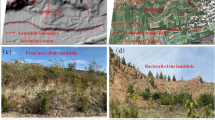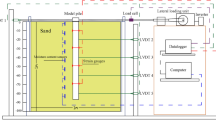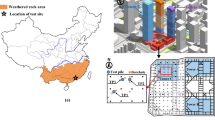Abstract
Open storage yards at industrial sites usually comprise several piles of granular materials, representing a particulate matter source that may significantly deteriorate air quality. The aeolian erosion of stockpiles is affected by changes in airflow patterns due to the pile shape and the presence of nearby piles or buildings. The aim of this study was to analyse the impact of wind erosion of successive parallel stockpiles on flow behaviour and particle emissions. A wind tunnel experiment was conducted in six configurations: one isolated pile and two successive piles separated by gaps of 0.9h and 1.8h (h is the pile height) oriented to 60° and 90° with respect to the main wind flow direction. The particles in the piles had a bimodal particle size distribution consisting of sand that was erodible (white) and non-erodible (black) in the investigated velocity range. The contrasting colours enabled the visualisation of the non-erodible sand accumulation. The mean field of the wall shear stress distribution and flow pathlines predicted by numerical simulation were associated with the experimental erosion patterns. The emitted mass was experimentally quantified as the difference between the initial and final stockpile weights. Downstream pile had a large impact on the aeolian erosion as it was highly eroded as a result of the impact of the particles emitted from the upstream pile. The emissions of the two consecutive stockpiles were greater than twice the emissions from an isolated stockpile for both orientations. Additionally, emissions were lower for configurations in which the piles were perpendicular.












Similar content being viewed by others
References
Andreotti B, Claudin P, Pouliquen O (2010) Measurements of the aeolian sand transport saturation length. Geomorphology 123(3–4):343–348. https://doi.org/10.1016/j.geomorph.2010.08.002
Badr T, Harion JL (2005) Numerical modelling of flow over stockpiles: Implications on dust emissions. Atmos Environ 39(30):5576–5584. https://doi.org/10.1016/j.atmosenv.2005.05.053
Badr T, Harion J-L (2007) Effect of aggregate storage piles configuration on dust emissions. Atmos Environ 41(2):360–368. https://doi.org/10.1016/j.atmosenv.2006.07.038
Chew LM, Aliabadi AA, Norford LK (2018) Flows across high aspect ratio street canyons: Reynolds number independence revisited. Environ Fluid Mech 18:1275–1291. https://doi.org/10.1007/s10652-018-9601-0
Cong XC, Yang SL, Cao SQ, Chen ZL, Dai MX, Peng ST (2012) Effect of aggregate stockpile configuration and layout on dust emissions in an open yard. Appl Math Model 36(11):5482–5491. https://doi.org/10.1016/j.apm.2012.01.014
Diego I, Pelegry A, Torno S, Toraño J, Menendez M (2009) Simultaneous CFD evaluation of wind flow and dust emission in open storage piles. Appl Math Model 33(7):3197–3207. https://doi.org/10.1016/j.apm.2008.10.037
Ferreira AD, Fino MR (2012) A wind tunnel study of wind erosion and profile reshaping of transverse sand piles in tandem. Geomorphology 139140:230–241. https://doi.org/10.1016/j.geomorph.2011.10.024
Ferreira Almerindo D, Lambert Rosebud J (2011) Numerical and wind tunnel modeling on the windbreak effectiveness to control the aeolian erosion of conical stockpiles. Environ Fluid Mech 11(1):61–76. https://doi.org/10.1007/s10652-010-9176-x
Fluent (2013) ANSYS Fluent User’s Guide. https://www.ansys.com/products/fluids/ansys-fluent. Accessed June 2019
Furieri B, Russeil S, Harion JL, Santos J, Milliez M (2012a) Comparative analysis of dust emissions: isolated stockpile VS two nearby stockpiles. WIT Trans Ecol Environ 157:9781845645823. https://doi.org/10.2495/AIR120251
Furieri B, Russeil S, Harion JL, Turpin C, Santos JM (2012b) Experimental surface flow visualization and numerical investigation of flow structure around an oblong stockpile. Environ Fluid Mech. https://doi.org/10.1007/s10652-012-9249-0
Furieri B, Russeil S, Santos JM, Harion JL (2013) Effects of non-erodible particles on aeolian erosion: wind-tunnel simulations of a sand oblong storage pile. Atmos Environ 79:672–680. https://doi.org/10.1016/j.atmosenv.2013.07.026
Gopalan H, Jaiman R (2015) Numerical study of the flow interference between tandem cylinders employing non-linear hybrid URANS-LES methods. J Wind Eng Ind Aerodyn 142:111–129. https://doi.org/10.1016/j.jweia.2015.03.017
Grandemange M, Gohlke M, Cadot O (2013) Turbulent wake past a three-dimensional blunt body. Part 1. Global modes and bi-stability. J Fluid Mech 722:51–84. https://doi.org/10.1017/jfm.2013.83
Huang G, Le Ribault C, Vinkovic I, Simoens S (2017) Part I : a priori study of erosion and deposition with large eddy simulation of turbulent flow over multiple 2D sandy Gaussian hills. Environ Fluid Mech. https://doi.org/10.1007/s10652-017-9552-x
Kheirabadi H, Mahmoodabadi M, Jalali V, Naghavi H (2018) Sediment flux, wind erosion and net erosion influenced by soil bed length, wind velocity and aggregate size distribution. Geoderma 323(February):22–30. https://doi.org/10.1016/j.geoderma.2018.02.042
Kim MK, Kim DK, Yoon SH, Lee DH (2008) Measurements of the flow fields around two square cylinders in a tandem arrangement. J Mech Sci Technol 22(2):397–407. https://doi.org/10.1007/s12206-007-1041-6
Kok J, Renno N (2006) Enhancement of the emission of mineral dust aerosols by electric forces. Geophys Res Lett 33(19):1–5. https://doi.org/10.1029/2006GL026284
Kurose R, Komori S (2001) Turbulence structure over a particle roughness. Int J Multiph Flow 27(4):673–683
Li L, Martz LW (1995) Aerodynamic dislodgement of multiple-size sand grains over time. Sedimentology 42(4):683–694. https://doi.org/10.1111/j.1365-3091.1995.tb00400.x
Lopes AMG, Oliveira LA, Ferreira AD, Pinto JP (2013) Numerical simulation of sand dune erosion. Environ Fluid Mech 13(2):145–168. https://doi.org/10.1007/s10652-012-9263-2 ISBN 1567-7419
Mollinger AM, Nieuwstadt FTM (1996) Measurement of the lift force on a particle fixed to the wall in the sublayer of a fully developed turbulent boundary layer. J Fluid Mech 316:285–306. https://doi.org/10.1017/S0022112096000547
Novak L, Bizjan B, Pražnikar J, Horvat B, Orbanić A, Širok B (2015) Numerical modeling of dust lifting from a complex-geometry industrial stockpile. J Mech Eng 61(11):621–631. https://doi.org/10.5545/sv-jme.2015.2824
San B, Wang Y, Qiu Y (2018) Numerical simulation and optimization study of the wind flow through a porous fence. Environ Fluid Mech. https://doi.org/10.1007/s10652-018-9580-1
Schlichting H (1968) Boundary layer theory. McGraw-Hill Book Company, New York
Shao Y, Lu H (2000) A simple expression for wind erosion threshold friction velocity. J Geophys Res: Atmos 105(D17):22437–22443
Smith Isaac B, Spiga A, Holt JW (2015) Aeolian processes as drivers of landform evolution at the South Pole of Mars. Geomorphology 240:54–69. https://doi.org/10.1016/j.geomorph.2014.08.026
Swet N, Katra I (2016) Reduction in soil aggregation in response to dust emission processes. Geomorphology 268:177–183. https://doi.org/10.1016/j.geomorph.2016.06.002
Torano JA, Rodriguez R, Diego I, Rivas JM, Pelegry A (2007) Influence of the pile shape on wind erosion CFD emission simulation. Appl Math Model 31(11):2487–2502. https://doi.org/10.1016/j.apm.2006.10.012
Turpin C (2010) Amélioration des modèles de quantification des émissions particulaires diffuses liées à l’érosion éolienne de tas de stockage de matières granulaires sur sites industriels. PhD diss, Ecole des Mines de Douai, Université de Valenciennes et du Hainaut-Cambrésis
Turpin C, Harion JL (2009) Numerical modeling of flow structures over various flat-topped stockpiles height: implications on dust emissions. Atmos Environ 43(35):5579–5587. https://doi.org/10.1016/j.atmosenv.2009.07.047
Turpin C, Harion JL (2010) Effect of the topography of an industrial site on dust emissions from open storage yards. Environ Fluid Mech 10(6):677–690. https://doi.org/10.1007/s10652-010-9170-3
Turpin C, Badr T, Harion JL (2010) Numerical modelling of aeolian erosion over rough surfaces. Earth Surf Proc Land 35(12):1418–1429. https://doi.org/10.1002/esp.1980
USEPA (2006). 13.2.5 Industrial wind erosion. Compilation of Air Pollutant Emission Factors, volume I: Stationary Point and Area Sources, AP-42
Van Doormaal JP, Raithby GD (1984) Enhancements of the SIMPLE method for predicting incompressible fluid flows. Numer Heat Transf 7(2):147–163. https://doi.org/10.1080/01495728408961817
Webb NP, Galloza MS, Zobeck TM, Herrick JE (2016) Threshold wind velocity dynamics as a driver of aeolian sediment mass flux. Aeolian Res 20:45–58. https://doi.org/10.1016/j.aeolia.2015.11.006 ISBN 1875-9637
Yang F, Yang XH, Huo W, Ali M, Zheng XQ, Zhou CL, He Q (2017) A continuously weighing, high frequency sand trap: wind tunnel and field evaluations. Geomorphology 293(March):84–92. https://doi.org/10.1016/j.geomorph.2017.04.008
Yeh CP, Tsai CH, Yang RJ (2010) An investigation into the sheltering performance of porous windbreaks under various wind directions. J Wind Eng Ind Aerodyn 98(10–11):520–532. https://doi.org/10.1016/j.jweia.2010.04.002
Zdravkovich MM (1977) Review of flow interference between two circular cylinders in various arrangements. J Fluids Eng 99(4):618–633. https://doi.org/10.1115/1.3448871
Acknowledgements
The authors acknowledge the financial support from Capes/Cofecub, Fapes and CNPq.
Author information
Authors and Affiliations
Corresponding author
Additional information
Publisher's Note
Springer Nature remains neutral with regard to jurisdictional claims in published maps and institutional affiliations.
Rights and permissions
About this article
Cite this article
Ferreira, M.C.S., Furieri, B., Santos, J.M. et al. An experimental and numerical study of the aeolian erosion of isolated and successive piles. Environ Fluid Mech 20, 123–144 (2020). https://doi.org/10.1007/s10652-019-09702-z
Received:
Accepted:
Published:
Issue Date:
DOI: https://doi.org/10.1007/s10652-019-09702-z




